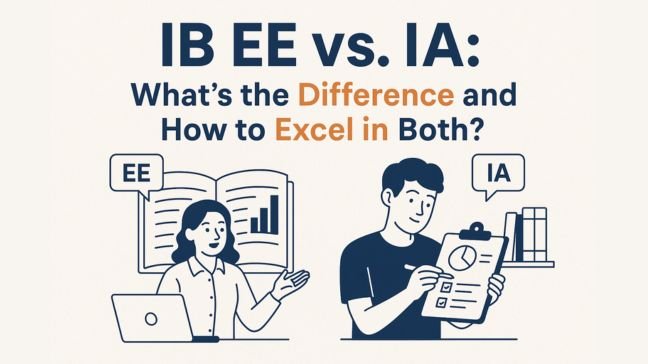If you’re an IB Diploma student, you’ve probably heard a lot about the IB EE vs IA debate. Both the Extended Essay (EE) and the Internal Assessments (IAs) are crucial parts of the IB curriculum, but they’re not the same, and understanding their unique purposes is key to excelling in both. While one tests your independent research skills across a broader academic landscape, the other dives deep into subject-specific mastery.
Let’s break down the IB EE vs IA comparison and guide you through strategies to succeed in both, because mastering them isn’t just about fulfilling IB requirements, it’s about building lifelong academic skills.
IB EE vs IA: Key Differences at a Glance
| Aspect | Extended Essay (EE) | Internal Assessment (IA) |
| Purpose | In-depth, independent research on a topic of your choice | Application of classroom knowledge in a practical context |
| Word Count | Up to 4,000 words | Typically, 1,500–2,500 words depending on subject |
| Assessment | Externally graded; contributes up to 3 diploma points | Internally assessed and externally moderated; 20–30% of grade |
| Guidance | Limited; a few meetings with a supervisor | Ongoing support from your subject teacher |
| Subject Flexibility | Any IB subject (even if not taken as a course) | Must be done in subjects you’re enrolled in |
| Focus | Critical thinking, structured research, argument building | Practical experiments, theoretical application, data analysis |
Understanding these differences is the first step in mastering the IB EE vs IA challenge.
The Purpose Behind Each: Research vs Application
In the IB EE vs IA context, the Extended Essay is a chance to engage with a topic you genuinely care about—be it Physics, Literature, History, or even something you’re not currently studying in class. This academic project lets you ask big questions and explore them in depth, much like a college-level paper.
Meanwhile, the IA is anchored in the classroom. It’s where you prove how well you understand the subject matter by applying it in real-world or theoretical investigations. Whether you’re analyzing economic data or conducting a biology experiment, the IA is about hands-on, focused exploration within set parameters.
Structure and Supervision: Who Helps You and How?
Another major distinction in the IB EE vs IA battle is in guidance and structure. The EE offers limited supervision—you’ll meet with a mentor only a few times throughout the process. That means more autonomy but also greater responsibility. You’ll need to handle everything from research to citations to formatting.
By contrast, IAs come with more continuous support from your subject teacher. You’ll get frequent check-ins, feedback on drafts, and help shaping your investigation. So, while the IA feels more secure, the EE gives you more academic freedom and independence.
Assessment Breakdown: What the IB Wants to See
Understanding how your work will be graded is vital when comparing IB EE vs IA:
EE assessment focuses on originality, clarity, research depth, structured argument, reflection, and academic presentation.
IA assessment emphasizes the research question, methodology, analysis, evaluation, and subject-specific language and concepts.
For both, the ability to explain why you made certain choices is crucial—whether that’s in selecting your sources or interpreting your results.
Research and Writing: Academic Muscles You’ll Build
Both EE and IA are rooted in research, but they build slightly different skills. When looking at IB EE vs IA from research and writing perspective:
The EE develops long-form writing, thesis development, and higher-level critical thinking. It often involves interdisciplinary connections and demands high-quality referencing (MLA, APA, etc.).
The IA sharpens analytical skills and precision. You learn how to apply theory to practice, summarize data, and discuss findings in a compact format.
For both, structured note-taking, source evaluation, and proper citations are non-negotiable. These are the tools of serious academic inquiry.
Tips to Succeed in Both: Your Dual-Track Game Plan

Here’s how to win at both sides of the IB EE vs IA challenge:
For the EE:
Start Early: Begin brainstorming topics in your first IB year.
Choose Passionately: Pick a subject that truly interests you—you’ll be living with it for a while.
Break It into Stages: Topic, research question, sources, writing, editing.
Reflect Deeply: Include meaningful reflections in your reflection space.
Get Organized: Use a planner or app to track deadlines and milestones.
For the IA:
Be Realistic: Choose a topic that’s feasible given your skills and available resources.
Stick to the Rubric: Know what your subject-specific rubric values.
Get Feedback Often: Make use of your teacher’s expertise early and often.
Use Real Data: Whether it’s an experiment or case study, real data makes your IA credible.
Keep It Focused: Avoid overcomplicating your question—depth beats breadth.
IB EE vs IA: Shared Success Strategies
Despite their differences, here are universal habits that work for both:
Plan Ahead: Use school breaks to get ahead.
Use Tools: Trello, Notion, or Excel to manage tasks.
Draft and Redraft: Great writing is rewritten writing.
Peer Review: A fresh pair of eyes can catch what you miss.
Keep Deadlines in Sight: Pacing prevents panic.
Final Thoughts on Mastering IB EE vs IA
Conquering the IB EE vs IA experience is more than a diploma requirement—it’s a chance to develop the kind of thinking and research skills that set you apart in university and beyond. The EE shows your ability to take initiative, explore deeply, and argue critically. The IA demonstrates your subject mastery, your practical application of theory, and your attention to analytical detail.
Together, they shape you into a capable, reflective, and independent learner.
Start early, stay focused, and use your resources wisely. Mastering the IB EE vs IA isn’t just about passing—it’s about preparing for the academic journey ahead.
Also Read = what-is-ib-board-all-you-need-to-know/
References:
Frequently Asked Questions ( FAQ )
Q1: What is the main ib ee vs ia difference?
A lingering whisper of distinction awakens curiosity. The Extended Essay is a 4,000‑word deep dive into a chosen subject, while the Internal Assessment is subject‑specific coursework set by IB. Excel in EE by crafting strong research questions and annotated bibliographies; shine in IA by following mark criteria precisely with clear analysis.
Q2: How are EE and IA scored differently?
Think of two maps with separate peaks. EE is externally assessed by IB examiners, scored out of 34 marks; IA is internally marked by teachers and moderated, with specific rubric criteria. To excel, use exemplar essays and mark schemes for practice.
Q3: How much time should I spend on EE vs IA?
Imagine balancing two delicate petals in your hands. EE often demands months of research, drafts, and supervisor feedback, while IA timelines depend on each subject’s schedule. Aim to schedule weekly milestones and set early draft deadlines.
Q4: Can research for EE help my IA too?
One spark can light two fires of achievement. While EE research is broader and more theoretical, parts may support IA analysis if relevant to your subject. Stay careful: each has its own criteria, structure, and scope.
Q5: What are common mistakes in EE and IA?
In the hush of student stress, pitfalls echo. Over‑broad research questions, weak citation, or ignoring the rubric plague both. To excel, refine your question tightly, cite consistently, and follow subject‑specific guidelines.
Q6: How can I improve my EE and IA scores?
The sweetest reward springs from disciplined routine. Break tasks into weekly goals, seek feedback early, and revise ruthlessly with rubrics front and center. Use exemplar work and teacher input to guide edits.
Q7: When should I start working on EE and IA?
A sunrise offers time to shape hope. EE research and planning should begin at the start of the diploma programme, while IA work often aligns with course content timing. Starting early eases pressure and builds depth.



